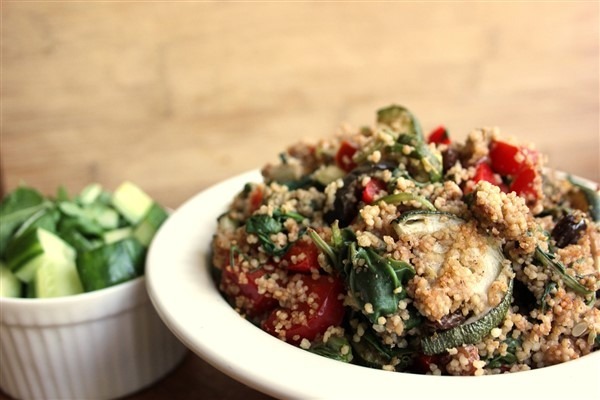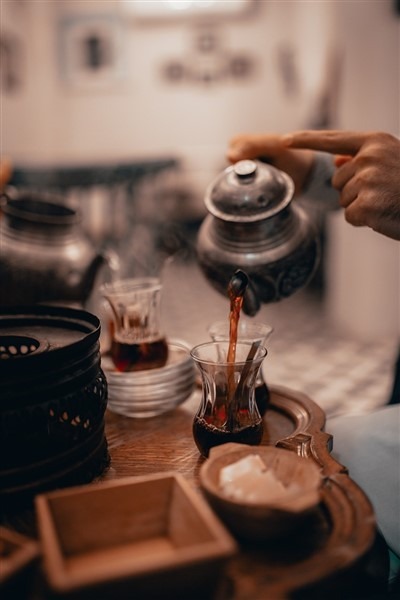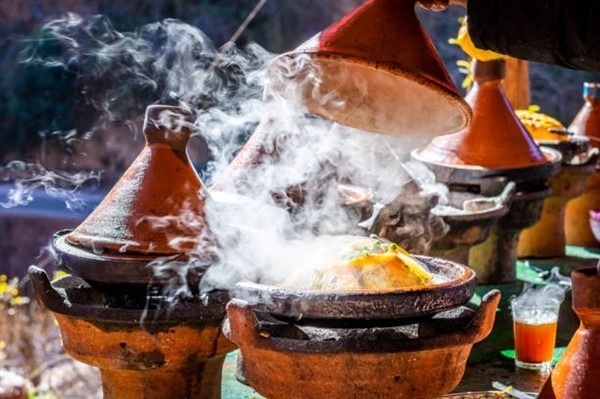Introduction
Moroccan cuisine is a tapestry of flavours, aromas, and traditions that have evolved over centuries. Rich in spices, fresh ingredients, and culinary techniques, Moroccan food offers a unique and unforgettable dining experience. Whether you’re a foodie planning a trip to Morocco or just curious about its cuisine, here are seven must-try dishes that will give you a true taste of Moroccan culture.
1. Tagine
What is Tagine?
Tagine is both the name of a North African dish and the earthenware pot in which it is cooked. The pot has a conical lid that allows steam to circulate, resulting in tender and flavorful food. This traditional dish is a cornerstone of Moroccan cuisine, known for its slow-cooked, succulent meats and vibrant vegetables.
Varieties of Tagine
There are numerous variations of tagine, each with its unique combination of ingredients and spices:
- Chicken with Preserved Lemons and Olives: This classic version combines tender chicken, tangy preserved lemons, and briny olives, creating a harmonious blend of flavours.
- Lamb with Prunes and Almonds: A sweet and savoury tagine featuring lamb, prunes, almonds, and a hint of cinnamon.
- Kefta (Meatballs) Tagine: Spiced meatballs simmered in a rich tomato sauce, often topped with eggs.
Cooking Method
Tagines are typically cooked over low heat for several hours, allowing the flavours to meld together beautifully. Common spices used include cumin, coriander, ginger, and saffron. The result is a dish that is both aromatic and deeply flavorful, perfect for communal dining.

2. Couscous
The Staple of Moroccan Cuisine
Couscous is a traditional North African dish made from tiny steamed balls of semolina flour. It is a staple in Moroccan households and holds a significant place in the country’s culinary traditions.
Varieties of Couscous
- Couscous with Seven Vegetables: A popular version that includes carrots, zucchini, turnips, and other vegetables, often served with lamb or chicken.
- Couscous Tfaya: Sweetened with caramelized onions, raisins, and cinnamon, this version is usually served with chicken.
Traditional Serving
Couscous is often prepared for special occasions and family gatherings, particularly on Fridays. It is traditionally served in a large communal dish, where family members gather around to share the meal, symbolizing unity and togetherness.
3. Harira
The Soul-Warming Soup
Harira is a traditional Moroccan soup that is particularly popular during the holy month of Ramadan. It is a hearty and nutritious soup that is often served to break the fast.
Key Ingredients
The main ingredients of Harira include tomatoes, lentils, chickpeas, and lamb, combined with a rich blend of spices such as turmeric, cumin, and cinnamon. Fresh herbs like cilantro and parsley add a burst of flavour.
Cultural Significance
During Ramadan, Harira is typically served with dates and chebakia (a type of Moroccan cookie) to break the fast. Its warm and comforting nature makes it a beloved dish in Moroccan households, providing nourishment and comfort after a day of fasting.
4. Pastilla
A Culinary Masterpiece
Pastilla, also known as bastilla or b’stilla, is a traditional Moroccan pie that exemplifies the country’s love for the fusion of sweet and savoury flavours. This dish is often reserved for special occasions due to its elaborate preparation.
Ingredients and Preparation
Traditionally made with pigeon or chicken, pastilla combines meat with almonds, eggs, and a variety of spices, all wrapped in layers of thin, flaky pastry known as warka. The pie is then baked until golden and crispy, and often dusted with powdered sugar and cinnamon.
Presentation and Flavor
The contrast between the savoury filling and the sweet, crunchy pastry creates a unique and unforgettable taste experience. Pastilla is typically served as an appetizer or a main course during celebrations and special gatherings.
5. Mechoui
The Art of Roasting
Mechoui is a traditional Moroccan dish that involves slow-roasting a whole lamb or a lamb shoulder. It is a festive dish often prepared for large gatherings and special occasions.
Preparation Method
The lamb is marinated with a blend of spices, including cumin, paprika, and garlic, then slow-roasted to perfection. In rural areas, mechoui is often cooked in a pit oven, which imparts a smoky flavour to the meat.
Serving and Tradition
Mechoui is typically served with bread and seasoned salt on the side. The meat is so tender that it can be easily pulled apart by hand. It is a dish that celebrates communal eating, with everyone sharing from a large platter.
6. Zaalouk
A Flavorful Side Dish
Zaalouk is a traditional Moroccan salad made from cooked eggplant and tomatoes. It is a versatile dish that can be served as a side dish, a dip, or a spread.
Ingredients and Preparation
The main ingredients in zaalouk are eggplants, tomatoes, garlic, and a blend of spices such as cumin and paprika. The vegetables are roasted or boiled until soft, then mashed together to create a chunky dip.
Serving Suggestions
Zaalouk is typically served warm or at room temperature, garnished with fresh herbs and a drizzle of olive oil. It pairs well with Moroccan bread (khobz) and can be enjoyed as part of a mezze platter.
7. Mint Tea
The National Drink of Morocco

Mint tea, also known as Moroccan tea or Maghrebi mint tea, is an integral part of Moroccan culture. It is more than just a drink; it is a symbol of hospitality and friendship.
Brewing and Serving
Moroccan mint tea is made by brewing green tea with fresh mint leaves and a generous amount of sugar. The tea is traditionally brewed in a special teapot and poured from a height into small glasses, creating a frothy top.
Cultural Ritual
Serving mint tea is a ritual in itself. It is often the first thing offered to guests and is a gesture of welcome and hospitality. The process of making and serving the tea is as important as the tea itself, reflecting the warmth and generosity of Moroccan culture.
Conclusion
Moroccan cuisine is a vibrant and diverse tapestry of flavours, colours, and aromas that reflects the country’s rich cultural heritage. From the aromatic tagine and comforting harira to the sweet and savoury pastilla and the refreshing mint tea, each dish tells a story of tradition and communal spirit.
Exploring these seven must-try dishes will not only satisfy your taste buds but also give you a deeper appreciation of Morocco’s culinary traditions. Whether you’re planning a trip to Morocco or experimenting with Moroccan recipes at home, these dishes are a great starting point for your culinary journey.










